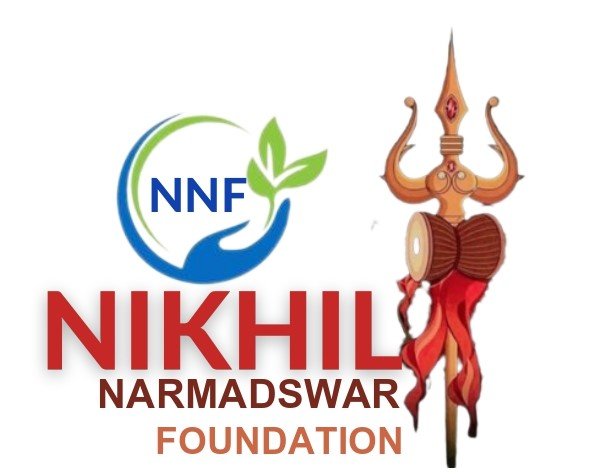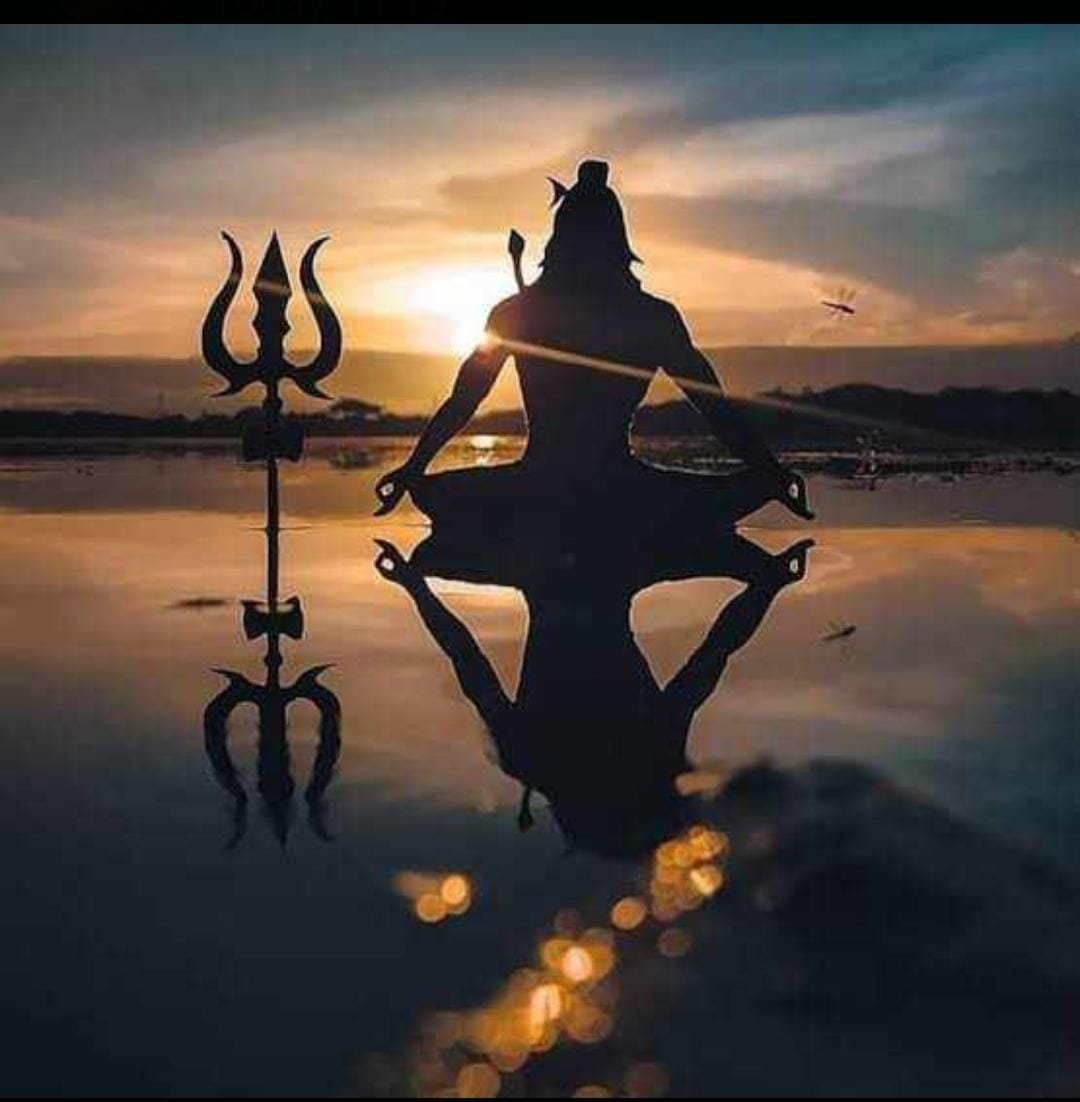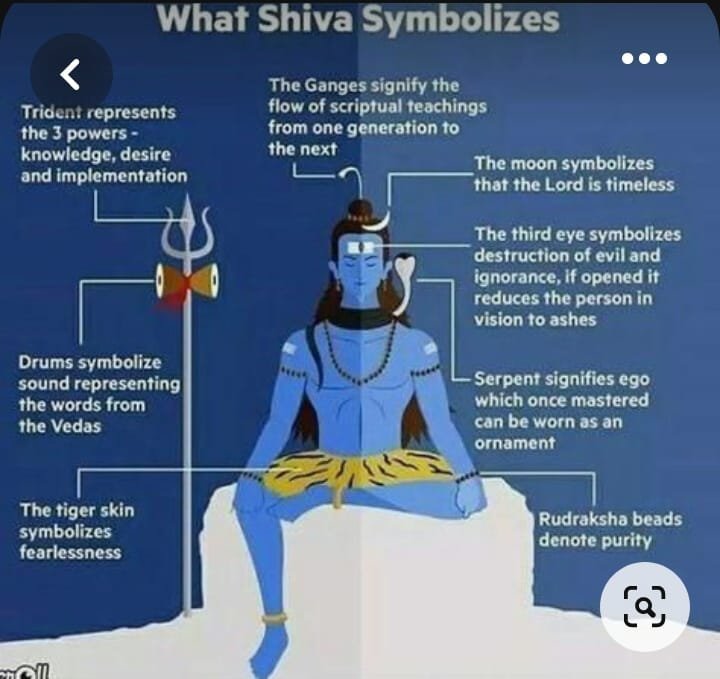Kailash Pravrat and lord Shiva
Divine Abode: Kailash Parvat is believed to be the heavenly residence of Lord Shiva. It is considered to be the place where he resides along with his consort, Goddess Parvati. Devotees regard this mountain as the ultimate pilgrimage site to connect with the divine.
Spiritual Significance:
Kailash Parvat is considered a powerful spiritual center. The mountain's unique energy is believed to facilitate spiritual growth, transformation, and self-realization. Many seekers and yogis flock to this sacred site to engage in meditation and seek spiritual enlightenment.
Mythological Connections:
In Hindu mythology, Kailash Parvat is depicted as the axis mundi, the cosmic pillar that connects the Earth with the heavens. It is believed that Lord Shiva resides at the summit of the mountain, meditating and overseeing the cosmic balance.
The Home of Shiva Linga:
At the base of Kailash Parvat lies the Mansarovar Lake, which is considered to be a sacred reservoir. Devotees believe that the lake's water possesses divine properties and has the ability to purify one's soul. Additionally, the mountain itself is revered as a gigantic Shiva Linga (phallic symbol representing Lord Shiva), enhancing its spiritual significance.
Pilgrimage Destination:
Kailash Parvat attracts countless pilgrims from various faiths, including Hindus, Buddhists, Jains, and Bon followers. The devout undertake the arduous Kailash Mansarovar Yatra, a pilgrimage circuit around the mountain, which is believed to cleanse one's sins and lead to spiritual liberation.
Symbol of Strength and Eternity:
Kailash Parvat represents the unyielding strength and eternal nature of Lord Shiva. The mountain's majestic presence and unconquerable stature serve as a reminder of Shiva's unwavering resolve and his role as the destroyer of ignorance and illusion.
Cultural and Artistic Inspiration:
Kailash Parvat has inspired countless artists, poets, and writers throughout history. Its awe-inspiring beauty, surrounded by pristine natural landscapes, has been depicted in various art forms, literature, and songs, spreading the divine essence of Lord Shiva's abode to a wider audience.
Universal Appeal:
Despite its deep-rooted connection with Hinduism, Kailash Parvat transcends religious boundaries and appeals to people of diverse backgrounds. Its spiritual magnetism and serene ambiance make it a place of reverence and introspection for individuals seeking inner peace and a deeper connection with the divine.
12 Jyotirlingas In India -
Shiva Temples Jyotirlingas are located all throughout the nation and are frequented by pilgrims and tourists from around the globe. This list of the
12 Jyotirlingas can be quite useful for planning and organising your journey. The names and locations of the
12 Jyotirlingas are listed below:
The Somnath-Gir Gujarati Somnath
This is one of the most famous Jyotirlinga in India. Somnath is the first of 12 Adhijyotirlingas and is considered his one of the most revered pilgrimage sites in the country. The architecture of the temple resembles the Chalukya style and it is believed that Lord Shiva appeared in this temple as a pillar of crackling light. The story of Shiv Purana shows that Moon married 27 daughters of Dakshin Prajapati. But Moon was cursed by Prajapati for neglecting all his wives except one. Rohini. To remove the curse and regain his lost brilliance and beauty, he worshiped Lord Shiva. The Almighty granted his wish and lived here forever as Somnath. Somnath His Jyotirlinga Temple in the Katiawad area has been destroyed and rebuilt nearly 16 times. There is no doubt that this temple is at the top of his list of 12 jyotirlingas, this jyotirlinga in Gujarat is an important landmark for travelers. Temple opening hours: Daily from 6am to 9pm. Aarti is held at 7am, 12pm and 7pm. Famous light and sound show. 'Joy Somnath' runs daily from 8pm to 9pm. How to get there: The nearest train station to Somnath is Veraval. It has good access to major cities in India and is only 5 km from Somnath. This distance can be traveled by taxi or cab
Gujarat's Nageshwar - Daarukavanam
Nageshwar Temple, located on the coast of Saurashtra in Gujarat, is a popular Jyotirlinga temple in India. Devotees from all over visit this temple throughout the year to seek blessings from the holy shrine of Nageshwar Mahadev, which is situated in an underground sanctum. The temple is situated between Gomati Dwarka and Bait Dwarka and offers a breathtaking view of the azure Arabian Sea, along with a 25-meter tall statue of Lord Shiva and a large garden. The Nageshwar Jyotirlinga is considered one of the most powerful Jyotirlingas in India, symbolizing protection from all types of poisons. The temple is open from 5 AM to 9 PM on all days of the week. Devotees can have darshan (worship) between 6 AM to 12:30 PM and 5 PM to 9 PM. To reach Nageshwar, the nearest railway stations are Dwarka station and Veraval station. If you prefer to travel by air, the closest airport to Dwarka is Jamnagar Airport, which is approximately 45 km away. It's worth noting that the information provided is based on the knowledge cutoff of September 2021, so it's always a good idea to double-check the current information before planning your visit.
Mumbai's Bhimashankar - Pune
Bhimashankar Temple is situated on the banks of the River Bhima in Maharashtra. It is a magnificent black rock structure built in the Nagara architectural style. The temple is surrounded by a wildlife sanctuary of the same name. According to legend, it is believed to have been constructed by Bheema, the son of Kumbhakarna. The shrine attracts a large number of pilgrims throughout the year, with Maha Shivratri being a particularly popular time for visitation. Additionally, visitors to Bhimashankar Temple often explore the nearby Kamalaja Temple, which is an incarnation of Parvati. This Jyotirlinga is highly revered and ranks among the most renowned Jyotirlingas in India. The temple is open every day from 4:30 AM to 12 noon and from 4 PM to 9:30 PM. Darshan (worship) commences at 5 AM and continues until 9:30 PM. However, during the afternoon Madhyan Aarti, darshan remains closed for 45 minutes. To reach Bhimashankar, the nearest railway station is Karjat station, which is approximately 168 km away. From there, you can cover the remaining distance by bus or rickshaw. Please note that the information provided is based on the knowledge cutoff of September 2021. It is advisable to verify the current details before planning your visit.
Nashik, Maharashtra's Trimbakeshwar
Trimbakeshwar Jyotirlinga is situated near the Brahmagiri mountain, which is considered the origin of the Godavari River, also known as Gautami Ganga. According to the Shiv Purana, both the Godavari River and Gautami Rishi implored Lord Shiva to make this place his abode, and thus Lord Shiva manifested himself in the form of Trimbakeshwar. One of the distinctive features of this Jyotirlinga is its shape. Instead of a traditional shrine, there is a void with three pillars placed inside. These three pillars symbolize the three most powerful and authoritative deities—Brahma, Vishnu, and Maheshwar. The temple is open from 5:30 AM to 9 PM every day of the week. To reach Trimbakeshwar, the nearest airport is Chhatrapati Shivaji International Airport. The closest railway station is Igatpuri Railway Station. Trimbakeshwar is located in Nashik and can also be reached by road. Please note that the information provided is based on the knowledge cutoff of September 2021. It is advisable to verify the current details before planning your visit.
Maharashtra's Grishneshwar - Aurangabad
Grishneshwar Temple is one of the 12 Jyotirlingas mentioned in the Shiva Purana. It boasts an impressive red rock structure in the 5-storied Shikhara architectural style. The temple is adorned with intricate carvings of various Gods and Goddesses, and it features a massive Nandi Bull in the main court hall. The temple is located near the renowned Ajanta and Ellora Caves. It was constructed by Ahilyabai Holkar and is also known as Gru Someswara and Kusum Eswarar. A notable attraction within the temple is the splendid sculpture of Vishnu's Dashavatar, which is carved on red rock and captivates the attention of every visitor. Grishneshwar Temple is considered one of the top tourist destinations in Aurangabad. For darshan (worship) and puja, the temple is open from 5:30 AM to 9:30 PM. However, during the month of Shravan (a Hindu lunar month), the darshan timings are from 3 PM to 11 PM. Typically, darshan takes a couple of hours. However, during the month of Shravan, when there is a significant increase in footfall, it may take around 6 to 8 hours to complete the darshan. To reach Grishneshwar Temple, you can travel to Aurangabad by train or flight from various parts of India. Delhi, for instance, offers direct trains and flights to Aurangabad. From Aurangabad, you can cover the remaining distance of approximately 30 km to Grishneshwar by road, either by hiring a taxi or using other means of transportation. Please note that the information provided is based on the knowledge cutoff of September 2021. It is advisable to verify the current details before planning your visit.
In Jharkhand, Vaidyanath-Deoghar
Vaidyanath Jyotirlinga, also known as Baidyanath or Vaijinath, holds great reverence among the 12 Jyotirlingas in India. It is also counted among the 52 Shakti Peethas, which are shrines associated with the Goddess Sati in Hindu mythology. According to mythological stories, Ravana, the demon king of Lanka, worshipped Lord Shiva for several years and requested him to come to Lanka. Lord Shiva appeared as a shivalinga and instructed Ravana not to place it down until he reached Lanka. However, Lord Vishnu intervened and tricked Ravana into keeping the shivalinga at rest for a while. Ravana disobeyed Shiva's instructions, and as a result, the shivalinga became permanently established as Vaidyanath in Deoghar. Vaidyanath is a popular Jyotirlinga in India, and the month of Shravana witnesses a high influx of devotees. People believe that worshipping this shrine of Lord Shiva can help alleviate their sufferings and lead them towards liberation and salvation. The temple is open on all seven days of the week from 4 AM to 3:30 PM and from 6 PM to 9 PM. However, during special religious occasions like Maha Shivaratri, the darshan timings may be extended. To reach Vaidyanath, the nearest railway station is Jasidih Junction, which can be reached from Ranchi. The temple is located just 15 km away from the station and can be easily reached by auto-rickshaw or cab. Please note that the information provided is based on the knowledge cutoff of September 2021. It is advisable to verify the current details before planning your visit.
Ujjain and Mahakaleshwar in Madhya Pradesh
Surrounded by the dense Mahakal forest, the Mahakaleshwar Temple in Ujjain is another prominent Jyotirlinga in India with immense spiritual significance. According to legend, the shrine was established by a five-year-old boy named Srikar, who was inspired by the devotion of King Chandrasena of Ujjain. The temple is located on the banks of the Kshipra River and is considered one of the seven Mukti-sthals in India, a place believed to liberate individuals to eternity. The temple is open from 4 AM to 11 PM, allowing devotees to experience darshan (worship) during specific timings. Darshan timings are from 8 AM to 10 AM, 10:30 AM to 5 PM, 6 PM to 7 PM, and 8 PM to 11 PM. To reach Mahakaleshwar, the nearest airport is Indore, located approximately 51 km away. Ujjain Junction, Chintaman, Vikram Nagar, and Pingleshwa are the four nearest railway stations to Mahakaleshwar. Please note that the information provided is based on the knowledge cutoff of September 2021. It is advisable to verify the current details before planning your visit.
The Madhya Pradesh town of Omkareshwar-Khandwa
Omkareshwar, which translates to 'Lord of the Om Sound', holds significant religious importance and is considered one of the most sacred places in India. It is situated on an island called Shivapuri in the Narmada River and has profound mythological significance. According to belief, there was a war between the Devas (celestial beings) and Danavas (demons), and the Devas sought the blessings of Lord Shiva for victory. Pleased with their prayers, Lord Shiva appeared as Omkareshwar and assisted the Devas in achieving triumph over the forces of evil. This legend contributes to the popularity of Omkareshwar as one of the prominent Jyotirlingas in India. The temple is open every day of the week from 5 AM to 10 PM. Devotees can have darshan (sacred viewing) between 5:30 AM to 12:20 PM and 4 PM to 8:30 PM. To reach Omkareshwar, the nearest airports are Indore (77 km) and Ujjain (133 km). Indore also has a major railway station located 77 km away from the temple. Additionally, buses are available from Indore, Ujjain, and Khandwa that connect to Omkareshwar. Please note that the information provided is based on the knowledge cutoff of September 2021. It is recommended to verify the current details before planning your visit.
Uttar Pradesh's Varanasi is home to Kashi Vishwanath.
Renowned as the Golden Temple in Varanasi, Kashi Vishwanath is a popular Jyotirlinga temple. It was constructed in 1780 by Maharani Ahilyabai Holkar, a Maratha monarch, and holds immense religious significance for Hindus. Devotees believe that Lord Shiva resides here, offering liberation and happiness to all. It is also considered one of the foremost Jyotirlingas in India, symbolizing the power of Lord Shiva surpassing other deities by breaking through the Earth's surface and reaching towards heaven. Kashi Vishwanath is among the most sought-after Jyotirlingas in the country. The temple opens every day at 2:30 AM and remains open until 11 PM. Below are the timings for the daily puja rituals and darshan: Mangala Aarti: 3 AM to 4 PM Sarva Darshan: 4 AM to 11 AM Bhog Aarti: 11:15 AM to 12:20 PM Sarva Darshan: 12:20 PM to 7 PM Sandhya Aarti: 7 PM to 8:15 PM Shringara Aarti: 9 PM to 10:15 PM Shayana Aarti: 10:30 PM to 11:00 PM To reach Kashi Vishwanath, Varanasi Junction is the nearest railway station, and the city has several other railway stations as well.
Kedarnath - Uttarakhand's Kedarnath
Located in the Rudra Himalayan Range at an altitude of 1200 feet, Kedarnath Jyotirlinga is renowned as one of the four dhams (sacred pilgrimage sites) in Hinduism. Due to the harsh winter conditions and heavy snowfall, the temple remains closed for six months and is open only from May to June. Before visiting Kedarnath, pilgrims typically visit Gangotri and Yamunotri to collect holy water, which they offer to the Kedarnath Shivalinga. It is believed that by visiting the Kedarnath temple and bathing the Jyotirlinga, one can alleviate unhappiness, ill luck, and misfortunes. The trek to Kedarnath is moderately difficult, and pilgrims often use walking sticks, mules, or dolis (carried chairs). The Samadhi (final resting place) of Shankaracharya, a famous Hindu saint, is located just behind the main Kedarnath temple. The temple is open from 4 AM to 12 noon and from 3 PM to 9 PM. To reach Kedarnath, Jolly Grant is the nearest airport, and Rishikesh is the nearest railway station. The nearest road connectivity is until Gaurikund, from where one can trek to Kedarnath.
Tamil Nadu's Rameswaram Island is known as Rameshwaram.
Rameshwaram Jyotirlinga is believed to have been worshipped by Lord Rama following his legendary victory over Ravana. Situated as the southernmost Jyotirlinga in the country, the temple is surrounded by the sea and is renowned for its beautiful architecture, ornate corridors, and 36 theerthams (sacred water bodies). Often referred to as the "Varanasi of the south," Rameshwaram Jyotirlinga is one of the most visited holy places in India. It can be reached via Madurai in Tamil Nadu. In addition to visiting the Jyotirlinga, devotees also make a point to visit Dhanushkodi beach, which is believed to be the place where Lord Rama built the Ram Setu (also known as Adam's Bridge) to Lanka in order to rescue his wife, Sita. Rameshwaram is also one of the Char Dhams (four abodes) of India. The temple is open from 5 AM to 1 PM and from 3 PM to 9 PM. The darshan (viewing of the deity) is allowed until 8 PM. To reach Rameshwaram, the nearest airport is in Madurai, which is approximately 163 km away. The town is also well-connected by rail from several major South Indian cities, including Chennai.
Srisailam in Andhra Pradesh, Mallikarjuna
Mallikarjuna Jyotirlinga temple, popularly known as the "Kailash of the South," is among the 12 Jyotirlingas in India. It is located atop Shri Saila Mountain, on the banks of the River Krishna. The temple showcases beautiful architecture, adorned with sculptures, gopurams (ornate gateways), and a mukha mandapa hall. Dedicated to Lord Shiva and his consort Bhramaramba or Parvati, Mallikarjuna Jyotirlinga is also recognized as one of the 52 shakti peeths associated with the mythological story of Sati. The temple of Mallikarjuna Jyotirlinga is considered one of the most significant Shaivite shrines in the country. The temple opens at 4:30 AM and remains accessible until 10 PM every day. The darshan (viewing of the deities) can be done between 6:30 AM to 1 PM and 6:30 PM to 9 PM. To reach Mallikarjuna, you can travel by road from nearby towns such as Doranala, Markarpur, and Kurichedu. The nearest railway station is Markapur railway station.




